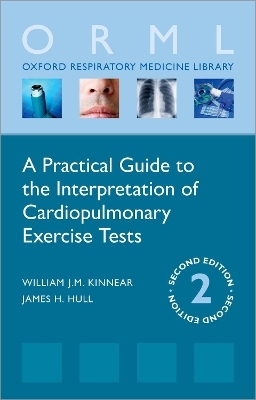
A Practical Guide to the Interpretation of Cardiopulmonary Exercise Tests
Oxford University Press (Verlag)
978-0-19-883439-7 (ISBN)
cardiopulmonary problems.
Part of the Oxford Respiratory Medicine Library (ORML) series, A Practical Guide to the Interpretation of Cardiopulmonary Exercise Tests, Second Edition provides readers with a practical, concise, and accessible approach to all aspects of cardiopulmonary exercise tests (CPET). CPET is often perceived as being incredibly complex to evaluate so this book breaks down interpretation to simple steps, allowing readers to rapidly understand the key points underpinning the application and interpretation of CPET. The text is focused and with the use of a substantial number of figures, learning points, and self-test questions helps readers to build confidence in undertaking and interpreting CPET.
The second edition has been extended and extensively revised in line with the latest international guidelines and evidence, and includes 16 fully updated chapters, 4 new chapters, and a new section of worked examples has been added.
William Kinnear is a Consultant Respiratory Physician at Circle Nottingham, Nottingham NHS Treatment Centre, Queen's Medical Centre Campus, Nottingham, UK and a Senior Lecturer in Sport Science at Nottingham Trent University. He studied at University College London and Westminster Hospital Medical School. He trained at the Brompton Hospital in London, Papworth Hospital and Addenbrooke's Hospital in Cambridge before moving to Nottingham. A Wellcome scholarship enabled him to spend a year at Erasmus Hospital in Brussels, developing his interest in respiratory muscle physiology. He worked as a consultant respiratory physician at the Queens Medical Centre in Nottingham for 25 years, setting up the regional non-invasive ventilation and sleep services. He introduced cardio-pulmonary exercise testing in the lung function laboratory and has published widely in the field of respiratory physiology. James H. Hull, PhD, FRCP, FACSM is a Consultant Respiratory Physician at the Royal Brompton Hospital, London, UK and Hon. Associate Professor at the Institute of Sport, Exercise and Health (ISEH), UCL, London. His interest in exercise testing started with an undergraduate degree in exercise physiology at St George's Hospital Medical School with Professor Brian Whipp. He later completed a PhD in vascular physiology and was then awarded a National Institute for Health Research Clinical Lectureship, during which he spent time at UCLA, California developing expertise in clinical exercise testing. He currently personally supervises over 250 CPET tests per year, as lead for the clinical unexplained breathlessness service at the Royal Brompton.
Abbreviations
SECTION 1 INTRODUCTION
1: Why do a CPET?
2: Pre-test assessment
3: Supervising a CPET
4: How to do a CPET
SECTION 2 KEY CPET PARAMETERS
5: Oxygen uptake
6: Heart rate
7: Oxygen-pulse
8: Ventilation
9: Carbon dioxide output
10: Respiratory exchange ratio
11: Ventilatory equivalents
12: Anaerobic threshold
13: Respiratory compensation point
14: Oxygen saturation
15: Additional respiratory measurements
SECTION 3 USING CPET DATA
16: Presentation of results
17: Interpretative strategy
18: Clinical scenarios
19: Pre-operative testing
20: Exercise prescription
APPENDICES
Learning point questions
List of learning points
Practical tip questions
List of practical tips
Example exam questions
Glossary
Bibliography
Index
| Erscheinungsdatum | 06.04.2021 |
|---|---|
| Reihe/Serie | Oxford Respiratory Medicine Library |
| Verlagsort | Oxford |
| Sprache | englisch |
| Maße | 139 x 216 mm |
| Gewicht | 302 g |
| Themenwelt | Medizinische Fachgebiete ► Innere Medizin ► Kardiologie / Angiologie |
| Medizinische Fachgebiete ► Innere Medizin ► Pneumologie | |
| Medizin / Pharmazie ► Medizinische Fachgebiete ► Sportmedizin | |
| ISBN-10 | 0-19-883439-X / 019883439X |
| ISBN-13 | 978-0-19-883439-7 / 9780198834397 |
| Zustand | Neuware |
| Haben Sie eine Frage zum Produkt? |
aus dem Bereich


